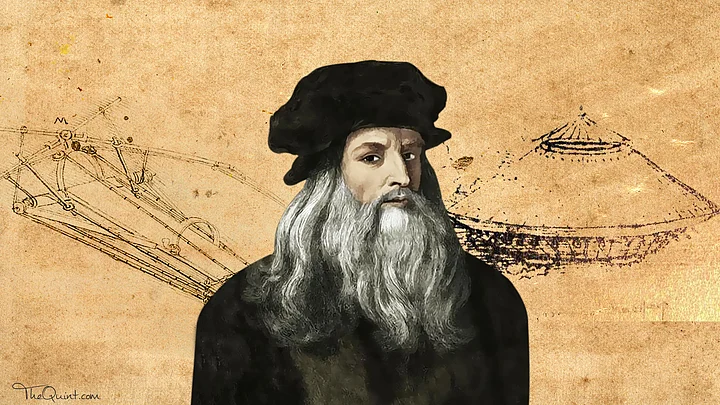(This article was originally published on 2 May 2017 and has been republished from The Quint’s archives to mark da Vinci’s death anniversary.)
The Mona Lisa is perhaps the most iconic and readily recognised pieces of art anywhere in the world. It’s widely regarded as Leonardo da Vinci’s greatest work. However, da Vinci wasn’t just a painter, he was an architect and an inventor too – one who’s ideas and thoughts foresaw some of mankind’s greatest inventions centuries before they came into existence.
Here are five inventions that da Vinci predicted long before they were invented.
The Helicopter
The achievement of flight by the Wright brother’s in 1905 was one of the human race’s greatest achievements. Da Vinci, however, had created the designs for a ‘flying screw,’ which was similar to the present-day helicopter, in the late 15th century.
Modern-day iterations of the helicopter include multiple blade sets with the ability to rotate at speeds never before imaginable. The physics behind its creation, however, owes itself to the mind of da Vinci. Beside his sketches of his creation he wrote:
“If this instrument made with a screw be well made – that is to say, made of linen of which pores are stopped up with starch and be turned swiftly, the said screw will make it spiral in the air and it will rise high.”
The Military Tank
If there was one salient truth about Leonardo da VInci. it’s that he never thought small. Under the tutelage of Ludovico Sforza in 1487, he designed what is now regarded as the prototype of the modern-day tank.
The covering was to be made of llama hair and reinforced with armadillo plates that would add to the thickness. Sharp, slanting angles would deflect enemy fire.
The machine was to be powered by two large inside cranks operated by four strong men. The vehicle would be equipped with an array of light cannons, placed around the perimeter.
The idea was yet another example of da Vinci’s genius and he intended to use the grandeur of the vehicle to intimidate the enemy without having to exercise real force.
Due to the sheer scale of production required to produce it, da VInci’s invention didn’t see the light of day. It is possible that da Vinci, a pacifist at heart, didn’t want his invention to see the light of day.
Revolving Bridge
In addition to pushing the limits of his own creativity, da Vinci’s inventions were also designed for the greater good. The revolving bridge is one such example.
The bridge was designed to swing across a stream or moat and set down on the other side so that soldiers could pass with little trouble. The device had wheels and incorporated a rope-and-pulley system for quick employment and easy transport.
It was also equipped with a counterweight tank for balancing purposes.
The temporary bridge was meant to help armies navigate unfamiliar terrain with less difficulty, and escape pursuing forces more easily. It was also intended to provide troops with what da Vinci believed was one of the most important aspects of warfare: mobility.
Parachute
While Louis-Sebastien Lenormand is credited with inventing the parachute in 1783, it was da Vinci who conceived the idea a few hundred years earlier.
Da Vinci made a sketch of the invention with this accompanying description:
“If a man have a tent made of linen of which the apertures [openings] have all been stopped up, and it be twelve braccia [about 23 feet] across and twelve in depth, he will be able to throw himself down from any great height without suffering any injury.”
Da Vinci’s design is made more stark by the use of a triangular, rather than a rounded, chute, leading many to wonder wether it would have enough air resistance to float. Since da Vinci’s parachute was to be made with linen covering a wood frame, the hefty weight of the device too was viewed as an issue.
Like many of da Vinci’s ideas, the invention was never actually built or tested by Leonardo himself.
The Flying Machine
Nothing quite exemplified the spirit of enlightened thought than da Vinci’s concept of the flying machine. Challenging the very notion of what was possible, da Vinci’s idea was one that literally reached for the skies.
Knows as the ‘ornithopter’, the invention differed from his flying screw as da Vinci wanted personal control of flight, similar to what a bird could achieve.
The two wings of the device feature pointed ends commonly associated with the winged creature. Da Vinci’s flying machine had a wingspan that exceeded 33 feet and the frame was to be made of pine covered in raw silk to create a light but sturdy device.
The pilot would lie face down on a board in the centre of the invention. To power the wings, the pilot would pedal a crank connected to a rod-and-pulley system. The machine also had a hand crank for increased energy output, and a head piece for steering.
As the busy pilot spins cranks with his hands and feet, the wings of the machine flap. The inspiration of nature in the invention is apparent in the way the wings were designed to twist as they flapped.
